#Bhutanese Headlines
Explore tagged Tumblr posts
Text
7 Interesting Facts About the Roads in Bhutan | DailyBhutan
Discover the captivating roadways of Bhutan with Daily Bhutan. Unearth intriguing facts about the unique and scenic roads that wind through the heart of the Himalayan Kingdom. Join us on a virtual journey and learn more about the marvels that make Bhutan's roads a destination in themselves.
0 notes
Text

Bhutan’s Bitcoin Boom: $780 Million Jackpot
Introduction
Nestled in the scenic shadow of the Himalayas, Bhutan—a picturesque landlocked country between India and China—is making headlines for an extraordinary reason. With a staggering Bitcoin reserve now valued at over $780 million, Bhutan's foray into the world of cryptocurrency has captivated the global financial stage. This impressive Bitcoin haul constitutes nearly one-third of the nation's Gross Domestic Product (GDP), making Bhutan's state-owned stash the fourth largest globally, as reported by on-chain analytics platform Arkham.
Bhutan: The Hidden Gem of Cryptocurrency
Bhutan, often celebrated for its stunning landscapes and unique cultural heritage, is now gaining international attention for its unexpected embrace of cryptocurrency. Known for prioritizing the well-being of its fewer than 900,000 citizens over conventional financial metrics, Bhutan is only the second country to hold Bitcoin, following El Salvador officially. This bold move is spearheaded by the country's state-owned investment arm, Druk Holdings.
A Deep Dive into Bhutan's Bitcoin Holdings
Bhutan's Bitcoin reserve is impressive in size and significant in its contribution to the country's economic landscape. With its holdings constituting a substantial portion of Bhutan's GDP, it underscores a remarkable national financial strategy shift. This reserve places Bhutan among the world's top Bitcoin holders, reflecting a bold and strategic investment in the digital currency.
The Role of Druk Holdings
Druk Holdings, Bhutan's state-owned investment arm, is at the forefront of this cryptocurrency revolution. Unlike many nations that acquire Bitcoin through law enforcement seizures, Bhutan has opted for a more proactive approach by mining Bitcoin directly. This strategic move is part of a broader investment plan to diversify the country's economic base.
Bitcoin Mining in Bhutan
Bhutan's rise in Bitcoin holdings is closely tied to its burgeoning mining operations. The largest of these facilities is located on the grounds of the now-defunct Education City project, highlighting Bhutan's innovative approach to leveraging its resources for cryptocurrency mining. This mining initiative represents a significant investment in the future of digital currency for the nation.
Partnership with Bitdeer
A pivotal element in Bhutan's Bitcoin strategy is its partnership with Bitdeer (BTDR), a prominent player in the cryptocurrency mining sector. In 2023, Bitdeer, headquartered in Singapore, partnered with the Bhutanese government to establish cryptocurrency mining operations in Southeast Asia. This collaboration secured over $500 million for the project and marked the beginning of a transformative phase in Bhutan's digital asset strategy.
Expansion Plans for Mining Operations
Bitdeer's initial 100-megawatt (MW) mining facility is just the beginning. By April 2024, Bitdeer plans to expand Bhutan's mining capacity to 600 MW by 2025. This significant expansion underscores Bhutan's commitment to becoming a major player in the global cryptocurrency market.
Economic Context of Bhutan
Despite its enchanting natural beauty and rich cultural heritage, Bhutan's economy remains relatively modest, with a GDP of just under $3 billion in 2022. This is approximately half the size of the Maldives' economy. Traditionally, Bhutan relies on hydropower, tourism, and agriculture sectors. However, the country's foray into cryptocurrency represents a bold step toward economic diversification.
Economic Diversification and Digital Assets
Druk Holdings is leading Bhutan's efforts to diversify its economic portfolio. This strategy requires a focus on digital assets, including cryptocurrency. This tech-driven approach also encompasses investments in hydropower and emerging technologies like the metaverse, aiming to position Bhutan as a forward-thinking player in the global economy.
Recent Bitcoin Wallet Activity
Recent activity in Druk Holdings' Bitcoin wallets reveals a dynamic and evolving strategy. Arkham's tracking indicates a flurry of deposits and withdrawals, including a notable transaction where over $25 million worth of BTC was transferred to Kraken, likely for sale. This active management of Bitcoin assets is a testament to Bhutan's strategic and responsive approach to cryptocurrency investments.
Global Implications and Reactions
Bhutan's Bitcoin venture has not gone unnoticed in the global cryptocurrency community. The country's substantial Bitcoin reserve and mining operations spark discussions and reactions worldwide. This bold move is seen as a significant development in the ongoing evolution of global cryptocurrency trends.
Challenges and Opportunities
While Bhutan's Bitcoin strategy is promising, it has challenges. The country must navigate potential regulatory hurdles, market volatility, and technological risks. However, the opportunities for Bhutan in the global crypto market are substantial, with the potential to enhance its economic standing and influence.
Conclusion
Bhutan's impressive Bitcoin reserve and mining operations are remarkable for this small yet ambitious nation. As Bhutan continues to embrace cryptocurrency and explore new economic avenues, it is poised to make a lasting impact on the global financial stage. The future looks bright for Bhutan's cryptocurrency journey, and the world will watch closely.
FAQs
What prompted Bhutan to invest heavily in Bitcoin? Bhutan's investment in Bitcoin is part of a broader strategy to diversify its economy and leverage its resources for future growth.
How does Bhutan's Bitcoin reserve compare to other countries? Bhutan's Bitcoin reserve is one of the largest globally, ranking fourth in total holdings.
What is the role of Bitdeer in Bhutan's Bitcoin operations? Bitdeer has partnered with Bhutan to establish and expand cryptocurrency mining operations, significantly contributing to the country's Bitcoin reserves.
How is Bhutan's economy affected by its Bitcoin holdings? Bhutan's Bitcoin holdings represent a substantial portion of its GDP and are part of its strategy for economic diversification.
What future developments can we expect from Bhutan's crypto investments? Future developments include further expansion of mining operations and continued exploration of digital assets and emerging technologies. About blocktour Block Tour brings you the most comprehensive coverage on Web3 and Blockchain. As the latest Web3 news updates platform, Block Tour ensures you stay ahead in the digital innovation space. Our platform offers expert insights and real-time news on key topics such as decentralized finance (DeFi) and blockchain technology. Discover the Block Tour difference with our Best Web3 News Platform for Daily Updates, keeping you informed about top projects, trends, and upcoming events in the world of NFT, Metaverse, smart contracts, dApps, play-to-earn, and DAOs. Trust Block Tour for all your Web3 and Blockchain news needs.
0 notes
Text
Squeezed by an India-China Standoff, Bhutan Holds Its Breath
By Steven Lee Myers, NY Times, Aug. 15, 2017
HAA, Bhutan--India’s main garrison in the Kingdom of Bhutan sits only 13 miles from a disputed border with China. There is a training academy, a military hospital, a golf course--all testament to India’s enduring role defending this tiny Himalayan nation.
Earlier this summer, China began extending an unpaved road in the disputed territory, and India sent troops and equipment to block the work. The incursion has resulted in a tense standoff that has lasted more than 50 days, with Indian soldiers facing Chinese troops who have dug in just a few hundred yards away.
At a time when North Korea and the United States are trading threats of war, China and India--the world’s two most populous nations--have engaged in increasingly bellicose exchanges over this remote border dispute, evoking memories of their bloody conflict in 1962 as the world’s attention was focused on the Cuban missile crisis.
There are fears that ambition and nationalism could lead them to war again, but now with more firepower at their disposal.
Caught between these two nuclear rivals seeking regional dominance is Bhutan, a mountain nation of 800,000 with a mystical reputation and a former king who popularized the concept of “gross national happiness” as a measure of a country’s well-being.
India says it is acting on Bhutan’s behalf in the standoff. But its intervention has not resulted in much gratitude here. On the contrary, many in Bhutan feel that India’s protective embrace has become suffocating.
“In the case of war between India and China, we would be the meat in the sandwich,” said Pema Gyamtsho, a leader of the opposition party in Bhutan’s National Assembly. “It shouldn’t have to be a choice,” he added, referring to his nation’s ties with India and China, “but it is at the moment.”
For decades, Bhutan has chosen India. More than a half century ago, Bhutan watched warily as China’s Communists took power and eventually occupied neighboring Tibet, with which it has close ethnic, cultural and religious ties. India offered to defend the kingdom, and Bhutan accepted.
But the latest standoff has inflamed festering resentments over India’s influence in the country. In particular, many suspect that India has sought to block Bhutan’s efforts to establish diplomatic relations and expand trade with Beijing, fearing that a rapprochement could remove the strategic buffer that Bhutan provides.
“Bhutan has every right to its sovereignty; that’s the crux of the thing,” said Wangcha Sangey, a former publisher and head of the Chamber of Commerce and Industry, who has been one of the most outspoken critics of India’s interference. “We have the right to live the way we want to live and to have the foreign relations we want to have.”
On the surface, the dispute turns on 34 square miles of land claimed by both Bhutan and China. India has accused China of extending the road to expand its control of the territory, with some comparing the move to Beijing’s efforts to cement its claims in the South China Sea by transforming reefs into islands.
The disputed area is strategically significant because it slopes into a narrow Indian valley that connects central India to its landlocked northeastern states. India calls it the Chicken’s Neck and has long feared that China could seize it in a war, splitting its territory.
But when India ordered its troops across the border on June 16, it seemed to do so without a request from Bhutan. While Bhutan has condemned the Chinese road work, it has studiously avoided saying whether it asked India to intervene. The Indian government has also avoided the question.
China has been talking tough, with near-daily warnings against India. Commodore Liu Tang, a deputy commander of the South China Sea Fleet, warned last week in The People’s Liberation Army Daily that China’s restraint thus far was “not without a bottom line.” The headline declared, “China’s territory is large, but not an inch of land is redundant.”
India has put more troops on alert in recent days, suggesting that it, too, is not prepared to back down.
In Haa, a small village an arduous day’s hike from where the troops are squaring off, the dispute is like distant thunder, a warning of storms that may come but are not yet anything to worry about.
The standoff does not, so far, involve Bhutanese forces, and state television and even the independent news media have followed the government’s lead and said virtually nothing about the conflict.
One resident of Haa said that a relative had happened on Chinese soldiers digging trenches while he herded his yak along the border. But the authorities have since closed the foot trails to the disputed area.
Many interviewed in Bhutan expressed more concern about India’s actions than China’s. Some note that one effect of India’s move--intended or not--has been to undermine border negotiations with China that could have cleared the way for closer economic ties.
There are four border areas in dispute: two in the north and two in the west, including the place where the standoff has unfolded. In 1998, China proposed ceding the northern areas to Bhutan in exchange for the western ones. And while Bhutan agreed in principle, a final agreement has not been reached.
After the latest round of talks in Beijing last year, the two sides seemed to be nearing a consensus, though prospects for a new round now seem uncertain.
Since signing a friendship treaty with India in 1949, Bhutan has relied almost exclusively on India for its defense. To this day India trains and pays the salaries of the Royal Bhutan Army, while its engineering corps builds and maintains Bhutan’s hairpin mountain roads. The exact number is not public, but India usually keeps 300 to 400 troops in Bhutan.
The relationship has evolved along with the country itself, and as fears that Bhutan could be subsumed by China have faded.
Part of the lure of better relations with China is money. In addition to the shuttle trade, there is tourism, one of Bhutan’s biggest industries. Indians do not need visas to travel to Bhutan, but Chinese must pay $250 a day in advance for vacation packages. Still, for the first time last year, more visitors came from China than from any other country besides India.
Chinese fascination with Bhutan bloomed after one of Hong Kong’s biggest movie stars, Tony Leung, married the actress Carina Lau here in 2008. The wedding three years later of the current king, Jigme Khesar Namgyel Wangchuck, also stoked interest after footage of it went viral in China.
Pema Tashi, who manages Happiness Kingdom Travel and advertises “a sojourn in paradise,” caters to Chinese clients with eight guides who speak Mandarin. He complained that there were no direct flights between Bhutan and China, and expressed suspicion that India had worked to prevent a normalization of relations that would open up such routes.
“We try to protect the interest of our big brother,” he said, referring to India, “but they feel that if we get closer to the north, we might not be as dependent on them.”
1 note
·
View note
Photo
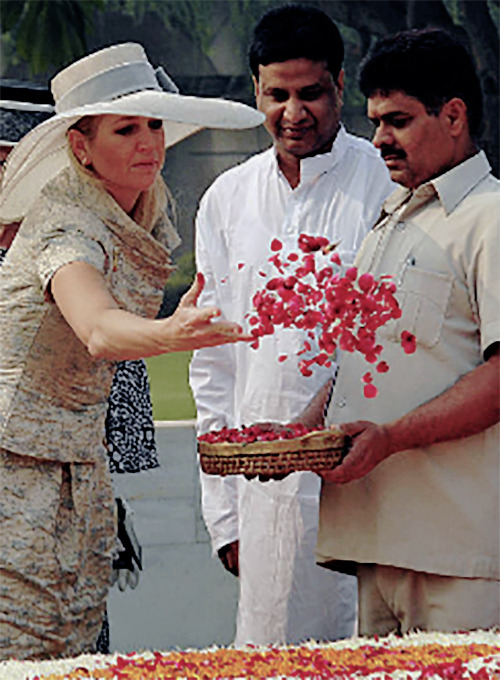
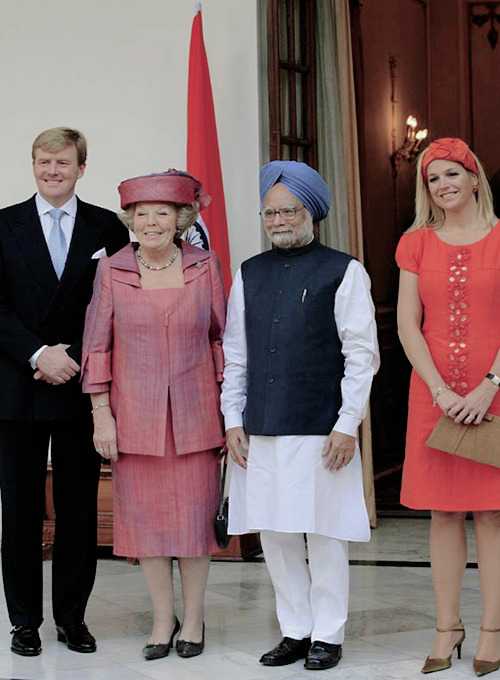

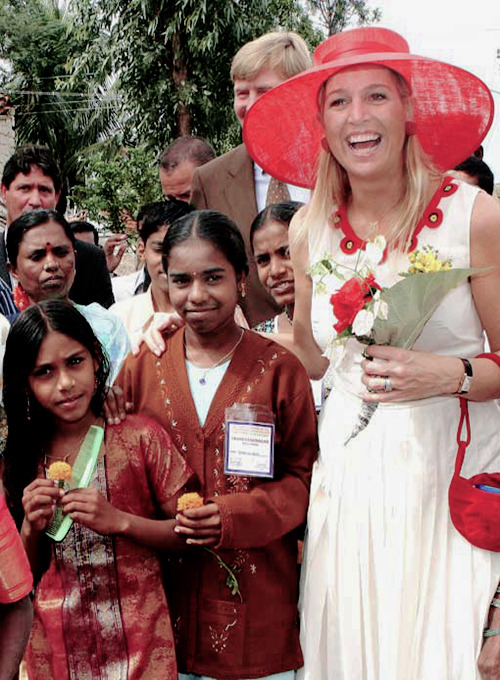
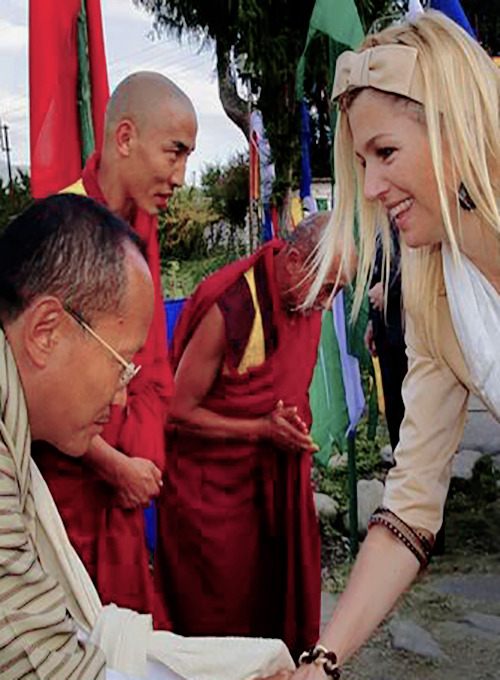


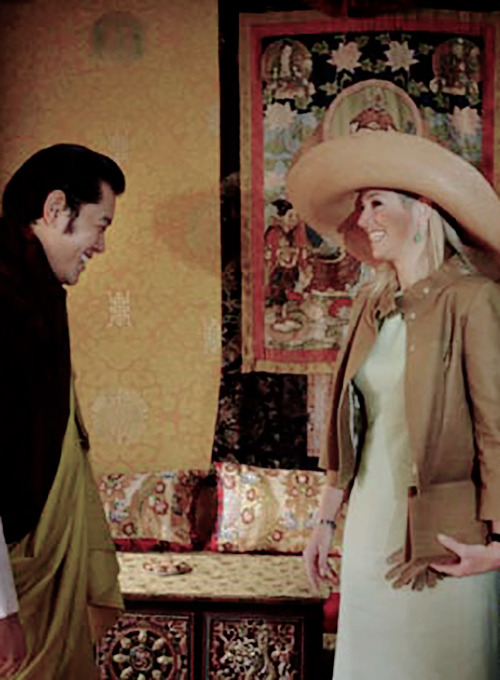
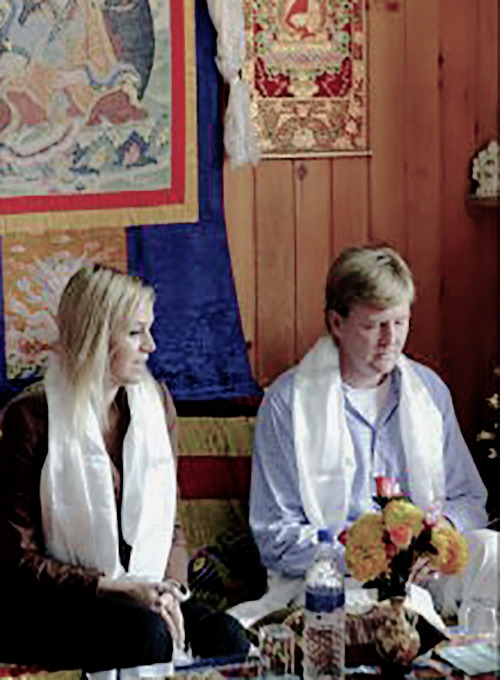
Queen Maxima’s foreign visits → India and Bhutan, 2007
Just a few days after the christening of their youngest daughter Ariane, Maxima and Willem Alexander flew out to India with then Queen Beatrix for a State Visit. The Netherlands was the fourth largest investor in India at the time so the visit was designed to improve their relations. As expected the visit centred around philanthropy, diplomacy and sight seeing: they visited an NGO training centre focusing on Maxima’s pet project of micro financing and a healthcare project in a school; they met with politicians and then President Patil, the first woman president of India; and they took in the site where Gandhi was cremated. After the trip, Maxima and Willem Alexander travelled onwards alone to Bhutan. They experienced some of the beautiful sites in the Dragon Kingdom. They took in temples, a monastery and the National Museum which promotes Bhutanese culture and history. The visit won plenty of headlines when Maxima turned her hand to archery, just as she had in Mongolia the year before, at a Centre which had been awarded the Prince Claus award for integrating women in to men’s sports. The itinerary was packed with interesting events, particularly a seminar on the National Happiness Index which Bhutan uses to measure happiness of its citizens rather than the traditional income related measures. Of course they also had a meeting with King Jigme Wangchuck. He was only 27 at the time and yet was highly popular; it’s likely Maxima and Willem Alexander had a lot to talk about as he would go on to become King just six years later at the age of 46, at which point he was the youngest monarch in Europe.
#maxtour#my upload#queen maxima#king willem alexander#dutch royal family#2007#overseas#queen beatrix
25 notes
·
View notes
Photo

The #birthday #barbecue occurred. May be #bbc or #cnn or #reuters didn't take it as a #headline but She is a #princess here. #bhutanese #tubri Made day more bright with her #birthday smile. Everyone wish betterment for this #birthdaygirl #沈阳航空航天大学 #universitylife #destination #time (at Shenyang, Liaoning)
#bhutanese#bbc#birthdaygirl#time#reuters#barbecue#cnn#princess#tubri#destination#headline#universitylife#沈阳航空航天大学#birthday
0 notes
Text
7 Benefits of Cordyceps: Harnessing the Power of Traditional Medicine | Dailybhutan
Discover the age-old secrets of Cordyceps, prized in Traditional Chinese Medicine (TCM) and herbalism. Uncover the multitude of health benefits linked to this remarkable fungus. Explore the natural wonders of Cordyceps and its potential to enhance your well-being
#Bhutan News#Headlines of Bhutan#News of Bhutan#Latest news in Bhutan#Bhutanese Headlines#Bhutan Prime Minister#Prime Minister Bhutan#Bhutan surgeon#Dr Lotay Tshering#bhutan#traveltobhutan#balanced tourism in bhutan#bhutan tours#Gross National Happiness#kingdom of bhutan#land of the thunder dragon#tours to bhutan#beverages#bhutanese beer#Bhutanese butter tea#red panda beer#bhutanese whiskey#Gong meditation#Singing bowl meditation#Sound healing#Sound therapy
0 notes
Link
Newspapers from Bhutan: Here is a largest and most comprehensive directory of free online Newspapers, Magazines, News websites, online television and radio channels from Bhutan having access to the current news on local and international affairs.
o APFA News
o BBS
o Bhutan Today
o Bhutanese
o Business
o Kuensel
o The Journalist
o Times
o New York Times Bhutan
o Bhutan News - Topix (EN)
o Bhutan Observer, Bhutan Latest News and Headlines (EN)
o The Bhutanese (EN)
0 notes
Text
Conjoined twins arrive in Melbourne from Bhutan for 'extraordinarily complex' separation surgery
New Post has been published on https://harryandmeghan.xyz/conjoined-twins-arrive-in-melbourne-from-bhutan-for-extraordinarily-complex-separation-surgery/
Conjoined twins arrive in Melbourne from Bhutan for 'extraordinarily complex' separation surgery
Updated October 02, 2018 16:58:43
Related Story: Twins set to go their own way
Map: Melbourne 3000
Surgeons from Melbourne’s Royal Children’s Hospital will attempt to separate 14-month-old conjoined twins who have arrived in Australia today after being flown in from their home in Bhutan.
Key points:
Bhutanese sisters were born conjoined at the chest and likely share a liver
Melbourne doctors have been planning the surgery for months
The operation will come nearly a decade after the successful separation of Trishna and Krishna
Nima and Dawa were born conjoined at the chest facing each other and scans carried out in Bhutan suggested they shared a liver.
Charity organisation the Children First Foundation is funding their flights and surgery, which doctors estimate could cost more than $300,000.
The two girls and their mother, Bhumchu Zangmo, arrived at Melbourne Airport about 11:45am and will meet with doctors tomorrow to begin assessments before what is expected to be an eight-hour operation.
“Based on reports we’ve had from the doctors and the imaging we’ve seen, they would appear to be joined and sharing mainly a liver, but we don’t know the exact anatomy of that,” said Mark O’Brien, head of surgery at the Royal Children’s Hospital told ABC Radio Melbourne.
Photo: A charity covered the cost of flying the twins from Bhutan to Melbourne. (ABC News)
“One of the first things we’ll have to do is assess them both physiologically to see how healthy they are and how fit they are for surgery and then to do some detailed medical imaging to assess the surgical plan.
“As you can imagine, it involves two anaesthetists, two sets of nursing teams in the theatre environment, it creates a level of complexity that’s out with the normal practice,” he said.
“We’ve been planning for this for a few weeks and we’ve liaised with all of the relevant teams to make sure that we have the appropriate space and the appropriate resourcing, and the nursing staff, anaesthetic staff, medical imaging, ICU, everybody that may have to be involved has been prepped.
“We hope not to need places like the intensive care unit but they’ve been briefed as best they can.”
Photo: Doctors will spend several more weeks assessing the twins before the operation. (ABC News)
Doctors hopeful both twins can survive
Dr O’Brien said based on the information available, the surgery required to separate the sisters appeared to be “at the easier end of the spectrum” of conjoined twins cases.
“Sometimes you have to make a decision that one twin would not make it … that does not appear to be the case with these two and we are hoping with the information we have to date that both twins will survive the surgery and go back to Bhutan,” he said.
“It’s a privilege to be able to give these children a very different life trajectory to the one that they’re currently set on and it’s something that is not possible in their home country.”
Dr O’Brien estimated the costs of surgery were likely to be more than $300,000 “assuming a straightforward and uncomplicated surgical and medical pathway”.
Photo: Hospital scans from Bhutan suggest the twins share a liver. (Supplied: Herald Sun)
Twins lost weight in recent weeks
The twins will need to gain weight and improve their nutrition before the surgery goes ahead, according to a doctor who recently visited the twins in Bhutan.
Chris Kimber is the head of children’s surgery at Monash Children’s Hospital and told ABC Radio Melbourne the hospital helps train doctors in Bhutan.
He said the twins were healthy when he visited them earlier this year.
Photo: A doctor says the surgery will likely cost more than $300,000. (Supplied: Herald Sun)
“In July they were pretty good, they were feeding well, gaining weight and looked well,” Associate Professor Kimber said.
“But in the last few weeks they had lost weight, their mother had reported that they were fighting, scratching each other and that she was unable to get both of them to sleep together, that there was always one of the twins awake and annoying.
“And as such they’d actually lost weight and they’d developed significant infective skin lesions related to the scratching.”
He said without the intervention of the charity organisation, the surgery would not be possible for the Bhutanese twins.
“For those of you who aren’t familiar with Bhutan, it’s the most remote and mountainous kingdom virtually in the world,” he said.
“There’s 800,000 people there that are widely spread out throughout valleys and very remote regions.”
Photo: Bhutanese conjoined twins Dawa and Nima will undergo surgery at the Royal Children’s Hospital. (Supplied: Children First Foundation)
Victorian Health Minister Jill Hennessy said she thought most Victorians would be touched by the case.
“This has been an extraordinarily complex preparation process involving very important considerations and decisions being made about the possible opportunities that could be offered to the twins by our clinicians here in Melbourne,” she said.
“It’s a matter of incredible pride that our teams are going to be putting their hands up to work and give these beautiful little girls their best chance at having a full and dignified life.
“To use your incredible clinical skills and your sense of compassion to step up to support this incredibly complicated case I think speaks not just to the ‘hero status’ that we should hold our clinical teams in, it also speaks to our very strong ethical compass around supporting all children.”
Doctors at the hospital made international headlines when they separated conjoined Bangladeshi twins Trishna and Krishna almost a decade ago, who were conjoined at the head.
Topics: medical-procedures, health, melbourne-3000, bhutan
First posted October 02, 2018 08:36:22
Source: http://www.abc.net.au/news/2018-10-02/conjoined-twins-flown-from-bhutan-to-melbourne-for-surgery/10327488
0 notes
Text
Discover Cultural Treasures: Authentic Bhutanese Souvenirs from Eastern Bhutan
Immerse yourself in Bhutan's rich cultural tapestry through authentic souvenirs from Eastern Bhutan. Explore unique local products crafted by rural communities, supported by the visionary leadership of Her Majesty the Queen. Embark on a journey of discovery with each handcrafted piece, a testament to Bhutan's vibrant heritage.
#Bhutan News#Headlines of Bhutan#Events of Bhutan#Latest event in Bhutan#Bhutanese Headlines#Bhutan Events#Upcoming Events#Sign up Daily Bhutan
0 notes
Text
70-year-old sound healer promotes sound healing in Bhutan through gong therapy
Explore the transformative journey of a 70-year-old sound healer in Bhutan, as she spreads the harmony of gong therapy to enhance mental and physical well-being. Discover the power of sound healing and its impact on Bhutanese culture and health. Join us on this resonating adventure.
#Gong meditation#Singing bowl meditation#Sound healing#Sound therapy#Bhutan News#Headlines of Bhutan#News of Bhutan#Latest news in Bhutan#Bhutanese Headlines
0 notes
Text
Discover the Role of De-suups: Guardians of Peace in Bhutan | Daily Bhutan
Explore the comprehensive guide to De-suups, Bhutan's Guardians of Peace, learning about their pivotal role in fostering community service, disaster management, and national unity. Gain insights into their training, values, and contributions to Bhutanese society on Daily Bhutan.
#Bhutan News#Headlines of Bhutan#Events of Bhutan#Latest event in Bhutan#Bhutanese Headlines#Bhutan Events#Upcoming Events#Sign up Daily Bhutan
0 notes
Text
Discover Bhutan's Magic: 6 Reasons to Own Your 'Bhutan Travelog' | DailyBhutan
Dive into the heart of Bhutan's beauty and culture with our latest blog post. Uncover the allure of Bhutanic landscapes and traditions in our 'Bhutan Travelog.' Explore 6 compelling reasons why it's a must-have for every travel enthusiast. From insider tips to hidden gems, this blog reveals the essence of Bhutan.
0 notes
Text
Discover A French Enthusiast's Deep Love for Bhutan | DailyBhutan
Explore the captivating journey of a French enthusiast's profound love for Bhutan on DailyBhutan. Immerse yourself in heartfelt stories, cultural encounters, and breathtaking experiences, as this unique bond between a foreigner and Bhutan unfolds. Join us in celebrating the profound connection between two cultures, beautifully captured in this inspiring tale.
#Bhutan News#Headlines of Bhutan#Events of Bhutan#Latest event in Bhutan#Bhutanese Headlines#Bhutan Events#Upcoming Events#Sign up Daily Bhutan
0 notes
Text
4 Uniqueness of Bhutanese School Life | Morning Assemblies and More | Dailybhutan.com
Explore the distinctive elements that make Bhutanese school life truly special. From morning assemblies to cultural richness, learn why schools in Bhutan stand out. Dive into the heart of Bhutan's education system.
0 notes
Text
8 Auspicious Symbols & Its Significance | Dailybhutan
It won’t take longer than a five minute stroll through any monastery, street, or bridge in Bhutan to find artistic representations of the 8 auspicious symbols of Buddhism. But these symbols aren’t present just for aesthetics. They represent the offerings received by Buddha from the gods after his enlightenment.
#Bhutan News#Headlines of Bhutan#Events of Bhutan#Latest event in Bhutan#Bhutanese Headlines#Bhutan Events#Upcoming Events#Sign up Daily Bhutan
0 notes
Text
7 Interesting Facts About the Roads in Bhutan | DailyBhutan
Discover the captivating roadways of Bhutan with Daily Bhutan. Unearth intriguing facts about the unique and scenic roads that wind through the heart of the Himalayan Kingdom. Join us on a virtual journey and learn more about the marvels that make Bhutan's roads a destination in themselves.
#mountaineous roads#roads in bhutan#biking in bhutan#Bhutan News#Headlines of Bhutan#Events of Bhutan#Latest event in Bhutan#Bhutanese Headlines#Bhutan Events#Upcoming Events#Sign up Daily Bhutan
0 notes